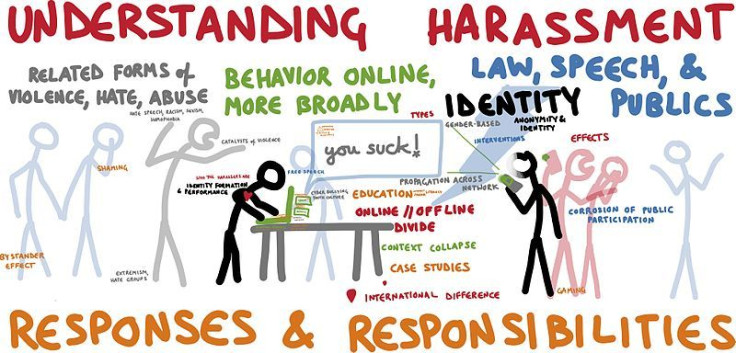Online Harassment In US Rising Because Anti-Cyberstalking Laws Are Not Enough

The biggest bane of the digital age — anyone can track you online, even if it is just to annoy you, harass or threaten you. Despite a number of laws, cyberstalking, cyberbullying and other forms of online harassment are on a steady rise in the United States.
Online harassment can range from threats, false accusations, solicitation for sex, slander, libel, defamation to identity theft, and vandalism, according to the Legal Dictionary. Harassment through electronic forms of communication may or may not take place in conjunction with stalking. This is because the former kind of harassment is easily carried out from behind a computer screen — something that has made it more rampant.
There can be several motives behind virtually stalking or harassing someone. The perpetrator might be looking to embarrass or humiliate the victim, exert financial control by hacking one’s bank account details, destroy the victim’s career and isolate him or her from their family and friends, instill fear in the victim by using a number of scare tactics, gain revenge over a broken relationship by posting salacious material involving the victim, among other motives.
According to a recent study conducted by Pew Research Center, 41 percent of the 4,248 poll participants from the U.S. said they were personally harassed online, and about 66 percent witnessed others being cyberstalked. Although most participants faced minor forms of harassment that could easily be shrugged off, 18 percent said the harassment was serious that left a long-lasting impression on their lives.
Read: Have The Anti-Abuse, Harassment Updates Actually Helped?
While 92 percent poll participants said they were familiar with what online harassment is, 62 percent of the people among these said it was a major problem despite increased awareness. The study found 14 percent of U.S. adults were targeted due to their political stance, followed by an individual's appearance (9 percent), race (8 percent), gender (8 percent), among other factors.

Referring to the online harassment due to political bias, another study conducted last year during the highly competitive presidential election, found 30 percent of 1,017 survey participants were harassed online because of their political stance. The study compared its results with a similar study conducted in 2014 where only 16 percent people said they were harassed over political reasons.
The study published by Online Harassment Data also analyzed the results from the standpoint of an array of demographics to get a better understanding of what the people faced at the time. It was seen while 79 percent of the people harassed for political reasons were aged between 55 and 64, only 28 percent of the millennials faced harassment due to the same reason.
When it comes to specific races that were targeted, it was revealed an equal percentage of Asians and Hispanics (34 percent) were targeted by the virtual perpetrators. It is worth mentioning a significant drop was noticed in the rate of African-Americans getting tortured. While 28 percent black people faced a rough time back in 2014, it dropped to 22 percent in 2016.
However, when it came to political camps, 29 percent of the Democrats, 24 percent of the independents, and 20 percent of the Republicans were harassed or at least knew someone who was tormented on the internet. Regarding the communicative mediums on the internet, 63 percent of the people named Facebook, followed by email (25 percent) and Twitter (20 percent).
Going by the general consensus, 59 percent of the people surveyed thought online harassment was more common than in-person bullying. Moreover, 48 percent of the people agreed that laws against cyber bullying need to be a lot stricter than they are at the present.
The Constitution provides some means to prevent cyberstalking, such as the Interstate Communications Law, which states: “Whoever transmits in interstate or foreign commerce any communication containing any demand or request for a ransom or reward for the release of any kidnapped person, shall be fined under this title or imprisoned not more than twenty years, or both.”
However, the glaring limitation to this law, as pointed out by a Harvard Law report, is it only applies to real time threats and is not necessarily applicable in situations where a person deliberately posts messages on a bulletin board or in a chat room with the intention of annoying, harassing or terrorizing another person.
Further, “The Interstate Stalking Act,” was signed into law by former President Bill Clinton in 1996. While this act does address the issue of harassment, it requires the stalker to have physically traveled across state lines in order to stalk his or her victim. It becomes redundant when it comes to internet stalking.
© Copyright IBTimes 2025. All rights reserved.






















